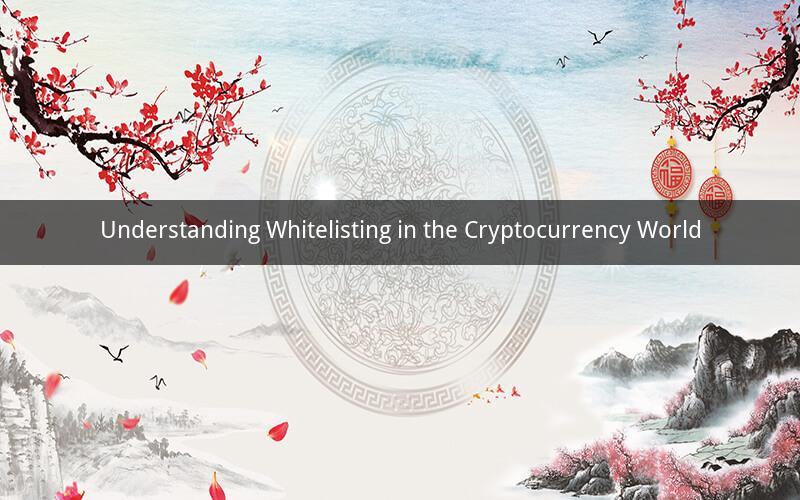
In the ever-evolving landscape of digital currencies, whitelisting has emerged as a crucial concept for ensuring security and compliance. But what exactly is whitelisting in the context of cryptocurrency? This article delves into the intricacies of whitelisting, its significance, and its impact on the cryptocurrency ecosystem.
Whitelisting in Cryptocurrency: A Definition
Whitelisting, in the realm of cryptocurrency, refers to the process of verifying and approving specific users or addresses to participate in a particular blockchain network or project. Unlike blacklisting, which involves banning or restricting certain entities, whitelisting is a deliberate and selective approach to granting access. In essence, it is a list of authorized participants who are granted permission to engage with a cryptocurrency platform, wallet, or exchange.
The Significance of Whitelisting in Cryptocurrency
1. Enhanced Security: Whitelisting serves as a security measure to prevent fraudulent activities and unauthorized access. By verifying the identity and reputation of participants, the risk of hacking and theft is significantly reduced.
2. Compliance with Regulations: In many jurisdictions, cryptocurrency projects are required to comply with anti-money laundering (AML) and know your customer (KYC) regulations. Whitelisting helps projects meet these requirements by ensuring that only legitimate users are granted access.
3. Mitigation of Risks: Whitelisting helps to mitigate the risks associated with initial coin offerings (ICOs) and other cryptocurrency projects. By vetting participants, projects can avoid potential legal and financial repercussions.
4. Community Building: Whitelisting fosters a sense of trust and exclusivity among participants. It encourages a community of engaged and responsible users who are more likely to contribute to the success of the project.
5. Efficient Resource Allocation: Whitelisting allows projects to allocate their resources more efficiently by focusing on a smaller, verified user base. This can lead to better user experience and improved project performance.
The Process of Whitelisting in Cryptocurrency
The process of whitelisting in cryptocurrency typically involves the following steps:
1. Identity Verification: Projects require participants to provide identification documents, such as passports or driver's licenses, to verify their identity.
2. Background Check: Projects may conduct background checks to ensure that participants have a clean record and are not associated with any fraudulent activities.
3. Approval: Once the verification process is complete, the project's team reviews the applicant's information and decides whether to approve or reject their request.
4. Whitelisting: Approved participants are added to the whitelist, granting them access to the project's platform, wallet, or exchange.
5. Continuous Monitoring: Projects may continue to monitor whitelisted participants to ensure compliance with regulations and maintain a secure environment.
Challenges and Concerns with Whitelisting
While whitelisting offers numerous benefits, it also presents certain challenges and concerns:
1. Privacy Concerns: Whitelisting requires participants to provide personal information, raising concerns about privacy and data protection.
2. Exclusivity: Whitelisting can create a sense of exclusivity, potentially excluding legitimate users who may not have the necessary resources to undergo the verification process.
3. Scalability: As the number of participants increases, the process of whitelisting can become time-consuming and resource-intensive.
4. Potential for Bias: The verification process may be subject to bias, potentially favoring certain individuals or entities over others.
5. Legal and Regulatory Challenges: Whitelisting may face legal and regulatory challenges, particularly in jurisdictions with strict data protection and privacy laws.
Frequently Asked Questions (FAQs) about Whitelisting in Cryptocurrency
1. What is the difference between whitelisting and blacklisting in cryptocurrency?
Whitelisting involves granting access to specific users, while blacklisting restricts access to certain entities.
2. Is whitelisting mandatory for all cryptocurrency projects?
No, whitelisting is not mandatory for all projects. However, it is a common practice, especially for those aiming to comply with regulations and enhance security.
3. Can whitelisted participants be removed from the list?
Yes, participants can be removed from the whitelist if they violate the project's terms and conditions or if their identity is found to be fraudulent.
4. How does whitelisting contribute to the success of a cryptocurrency project?
Whitelisting enhances security, mitigates risks, and fosters a sense of trust and exclusivity among participants, contributing to the overall success of the project.
5. Is whitelisting a permanent process?
No, whitelisting is not a permanent process. Projects may need to update the whitelist periodically based on changes in user requirements and regulatory compliance.
In conclusion, whitelisting plays a crucial role in the cryptocurrency ecosystem by ensuring security, compliance, and efficient resource allocation. While it presents certain challenges and concerns, its benefits make it an essential practice for many projects. By understanding the process and its implications, participants can make informed decisions about their involvement in whitelisted cryptocurrency projects.